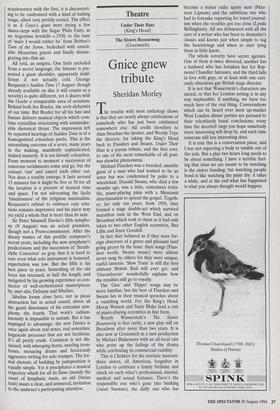Music
Puzzles of the Proms
Robin Holloway
Far the most puzzling as yet amongst this year's Proms novelties was the British premiere of Alexander Goehr's Colossus or Panic (2 August). The inspiration comes from the Goya with the same odd double- name. Once seen never forgotten, the small painting of the vast male nude figure, standing as if over the edge of the world, his back three-quarters to the viewer, in apparent indifference to the hordes of men and beasts fleeing the terrain.
As straightforward evocation in music of an image like, say, Rachmaninov's response to Bocklin's Isle of the Dead, the Goehr is a failure. But he would probably call such an aim banal. A subtler depiction of distur- bance, the discrepancy between calm and terror, vastness of subject and minuteness of treatment, is what he seeks. But this doesn't seem to work either. The piece is basically languid, its energy intermittent and half-hearted. Like deux etudes, its clos- est precursor in Goehr's output, it comes in a pair whose second is weaker than its first. The opening section contains characteristi- cally distinguished things: best is the very start, a gesture of ambiguous power, soon lost in witterings and stutters, then revving up into machine-like momentum that in turn collapses into jerks and spasms. It's attention-compelling; if you let a few sec- onds slip you return to a new place. Yet it's also attention-repelling; slippery, evasive, resistant to concentration. Any harshness or violence that the subject might well elicit is absent. A lost clarinet quintet of Spohr, an imaginary violin concerto of Bruch seem to underly the general sweetness; against it the sudden eruptions of violent percussion seem annoyingly gratuitous.
In the second section the incongruities become acute. After one has wriggled into acquiescence with the first, it is disconcert- ing to be confronted with a kind of halting tango, albeit very prettily scored. The effect is as if Goya's giant were trying a few dance-steps with the Sugar Plum Fairy, in an Argentine bordello c.1930, to the tune of 'malo I would rather be' from Britten's Turn of the Screw, bedecked with unsuit- able Mozartian graces and finally disinte- grating into thin air.
All told, an enigma. One feels excluded from a secret language; the listener is pre- sented a giant shoulder, apparently indif- ferent if not actually cold. George Benjamin's Sudden Time (7 August: though already available on disc it still counts as a novelty) is quite different, yet it shares with the Goehr a comparable aura of arcanum. Behind both lies Boulez, the arch-alchemist of our time. But Boulez for all his fuss and finesse delivers musical objects which com- bine crystalline structuring with unmistake- able rhetorical thrust. The impression left by repeated hearings of Sudden Time is of a homogenised colourless puree. This is the astonishing outcome of a score, many years in the making, manifestly sophisticated, indeed masterly. It is not literally colourless. From moment to moment a succession of sonorous ravishments come and go, but the colours 'run' and cancel each other out. Nor does a totality emerge; it lasts around 15 minutes but it might be five or 50 for all the location is a process of musical time and space. I'm not advocating the facile `timelessness' of the religious minimalists. Benjamin's refusal to embrace easy solu- tions remains impressive and his piece may yet yield a whole that is more than its sum.
Sir Peter Maxwell Davies's fifth sympho- ny (9 August) was an actual premiere, though not a Prom-commission. After the dreary wastes of this prolific composer's recent years, including the new symphony's predecessors and the succession of 'Strath- clyde Concertos' so gray that it is hard to care even what solo instrument is featured, expectation was low. But the fifth is his best piece in years. Something of the old force has returned, at half the length, and mitigated by his growing experience as con- ductor of well-orchestrated masterpieces by, inter alia, Debussy and Sibelius.
Sibelius looms close here, not as pious abstraction but in actual sound; above all the gaunt dissonance of his extremist sym- phony, the fourth. That work's radium- intensity is impossible to sustain. But it has impinged to advantage; the new Davies is once again about real notes, real sonorities, largescale processes that are not factitious. It's all pretty crude. Corniness is not dis- dained, with whooping horns, snarling trom- bones, menacing drums and ferociously aggressive writing for solo trumpet. The for- mal rhetoric of building by juxtaposition is equally simple. Yet it precipitates a musical trajectory which for all its flaws (mainly the onset of lymphatic stasis, an old Davies trait) issues a clear, and answered, invitation to the audience's participating attention.



















































 Previous page
Previous page